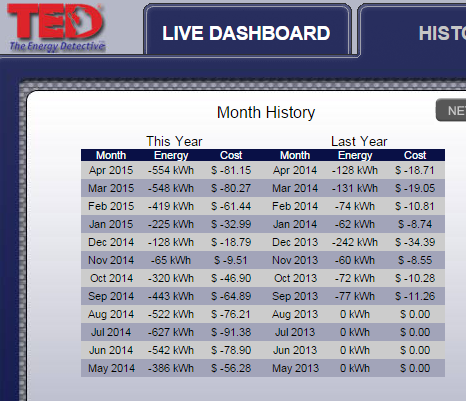No that is where you start. Next you look up thee Patent and UL applications.
Tesla is using the same batteries they are using in the S model car. If you know anything about batteries, the most basics of physical properties, is that batteries physical size in volume and weight are directly proportional to the energy capacity contained within them. A 10 Kwh battery is going to be 42% larger and heavier than a 7 Kwh battery. It is simple 5th grade math.
Tesla Wants to Build a Battery for Your House
Collapse
X
-
And the math gets worse when you assume system efficiency (approx 90%) and battery degradation over time. Then, probably double the price for additional equipment, materials and installation = throwing money away. Hopefully, the early adopters don't mind, and we will have an affordable option 5 or 10 years down the road.Leave a comment:
-
Based on that data, I concur that it doesn't sound like any kind of deal. Even @ 3K installed, optimal payback is 2 years after the guarantee expires.Leave a comment:
-
You can reserve one and get your price.
The reservation process should tell you the distributors in your area, if any. This battery will likely only work with inverters designed specifically to the unit. The Powerwall does not appear to be designed for end user installation.Leave a comment:
-
There's no empirical data that I could find anywhere on the site to support the contention that $3,000 was not the cost I'd pay if I reserved a 7KWh battery today. Do you have this data? Agree that installation costs are probably extra but I was doing "rough numbers". I'm not saying this is an incentive to buy one either: the guarantee is only for 10 years I believe.
"Tesla’s selling price to installers is $3500 for 10kWh and $3000 for 7kWh. (Price excludes inverter and installation.) Deliveries begin in late Summer."
Tesla's massive Powerwall battery promises to be able to take homes and businesses off the grid. Here's a sanity check on how realistic it is, and what it means for the energy market.
"SolarCity will install Tesla's batteries for $5,000 (which is on top of the $3,500 price tag for the battery itself)."Leave a comment:
-
Agree on that. Here's output from my 4KW system.

However, right now, grid-tie is good, but demand charges can change this. POCOs need to do demand charges and I agree with them, however, they can do it cheaper once they have cheaper energy storage systems. Local placement of large storage systems not only supports renewables, but also reduces load on transmission lines.Leave a comment:
-
There's no empirical data that I could find anywhere on the site to support the contention that $3,000 was not the cost I'd pay if I reserved a 7KWh battery today. Do you have this data? Agree that installation costs are probably extra but I was doing "rough numbers". I'm not saying this is an incentive to buy one either: the guarantee is only for 10 years I believe.Leave a comment:
-
solar98.JPG
SCE has credited me almost that much... in three months. This is after solar has provided for 99% of my use.
Go Solar!!Leave a comment:
-
$3000 is the wholesale cost, then you figure in retail mark up & install. You are probably looking close to double $$/Leave a comment:
-
Here's WE Energies' time-of-use plan:
Time-of-Use can save money on your electric bill if you can use large appliances on evenings and weekends rather than weekdays.
peak rates are mornings - evenings (WE energies lets you designate this to 12 hour periods beginning at 7, 8, or 9AM). The battery use case leverages the 12 hour off-peak rates and delivers energy during peak rate times.
So here's some rough numbers...
Given that the 7KWh battery can shift 7KWh/day, and given the WE Energies rate difference of about .10/kwh we get .70/day saved or about $255/year.
Given 3,000 cost, payback is about 12 years with this use case. Not sure if its $3,000 installed or not... This also assumes that your home uses at least 7KWh/day during peak hours of course.Leave a comment:
-
1. Mornings are also "Off Peak". "Peak" is in the afternoons, when most homes are empty ( gone to work , gone to school) No need for power thenMy understanding is that the batteries are targeted at two usage scenarios:
- they can charge using off-peak rates (hours surrounding midnight) and discharge during peak rates (waking hours) allowing customers to take better advantage of tiered rates.
- they can be used in conjunction with a solar array. Since peak home usage is generally during the time you cite and also in the morning (shown on Tesla's site and I can validate empirically based on my own TED5000 history), the battery can leverage a solar array to store energy during peak output times (usually around noon when sun energy is highest and overall energy use is negative) and release it during morning/evening hours.
2. Solar alone has a 5 to 10 year payback window. Adding the costs of one of these might push it out to 15, 20 years? Why bother?Leave a comment:
-
Leave a comment:
-
Leave a comment:
-
Leave a comment:
-
Post a link from Tesla please that states exactly what your saying.I am typing slowly so you can understand and did not listen the first 50 times when it was announced.
Only difference between them is the firmware to restrict the DOD. Both are a 400 volt 25 AH battery (10 Kwh). Same cabinet, exact same dimensions, exact same weight, exact same battery, just different firmware in the code that restricts DOD.Leave a comment:



Leave a comment: